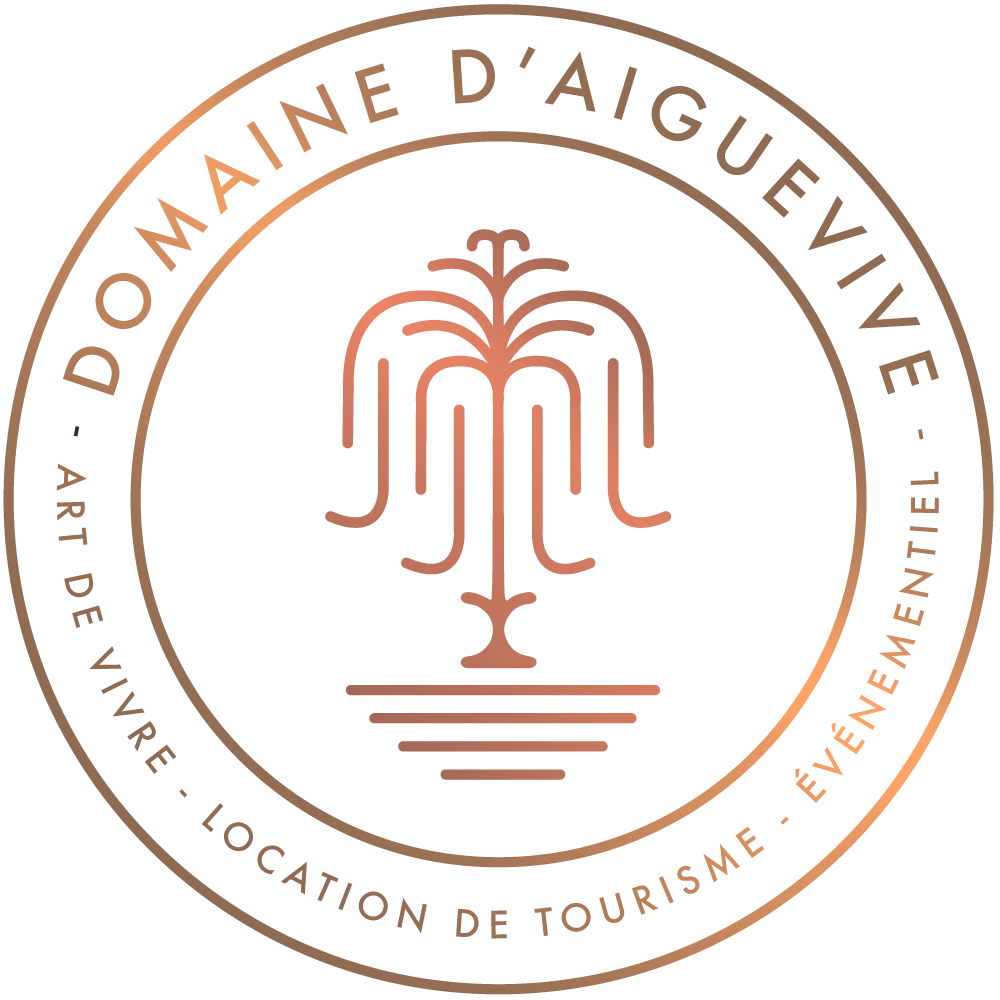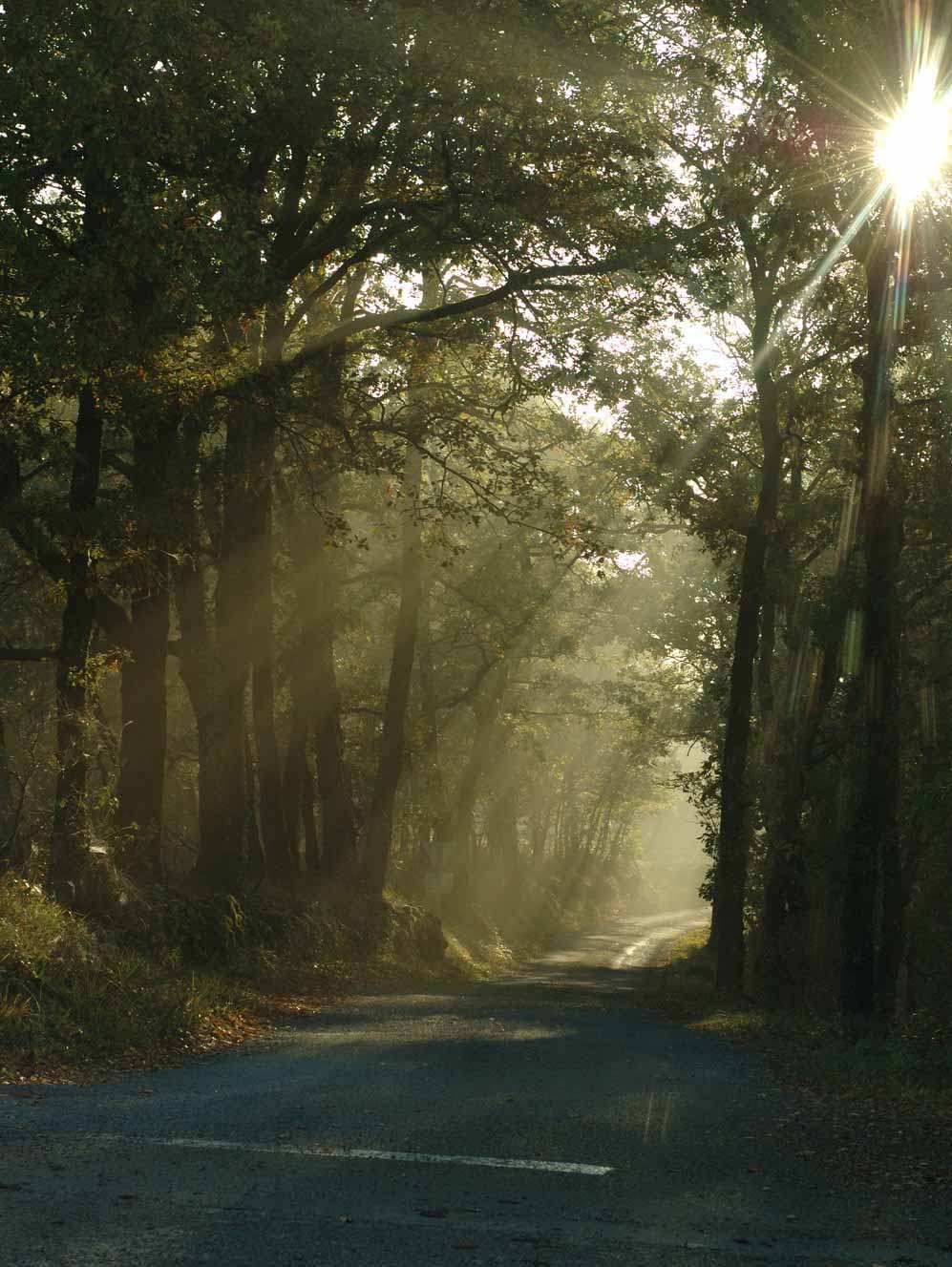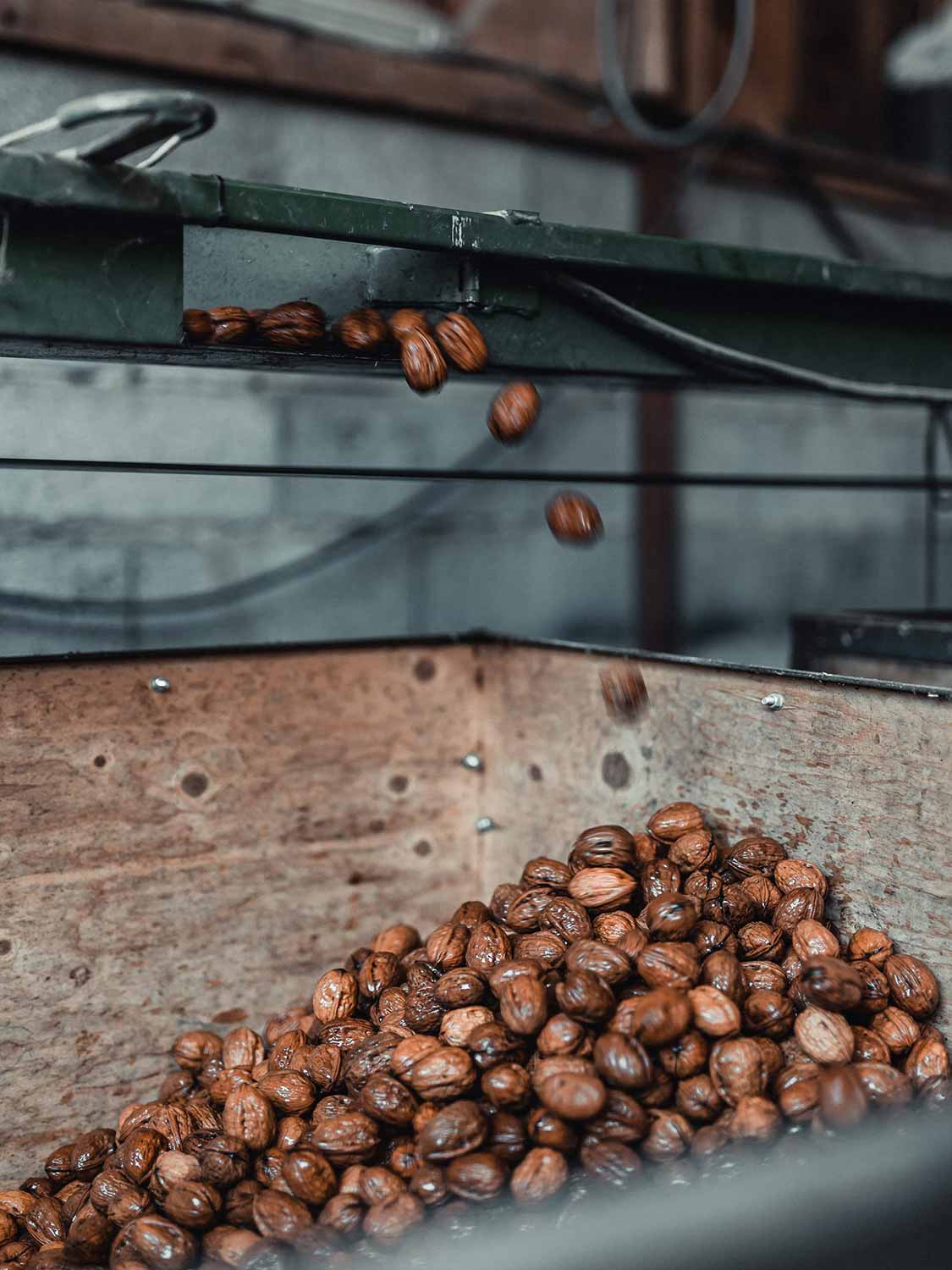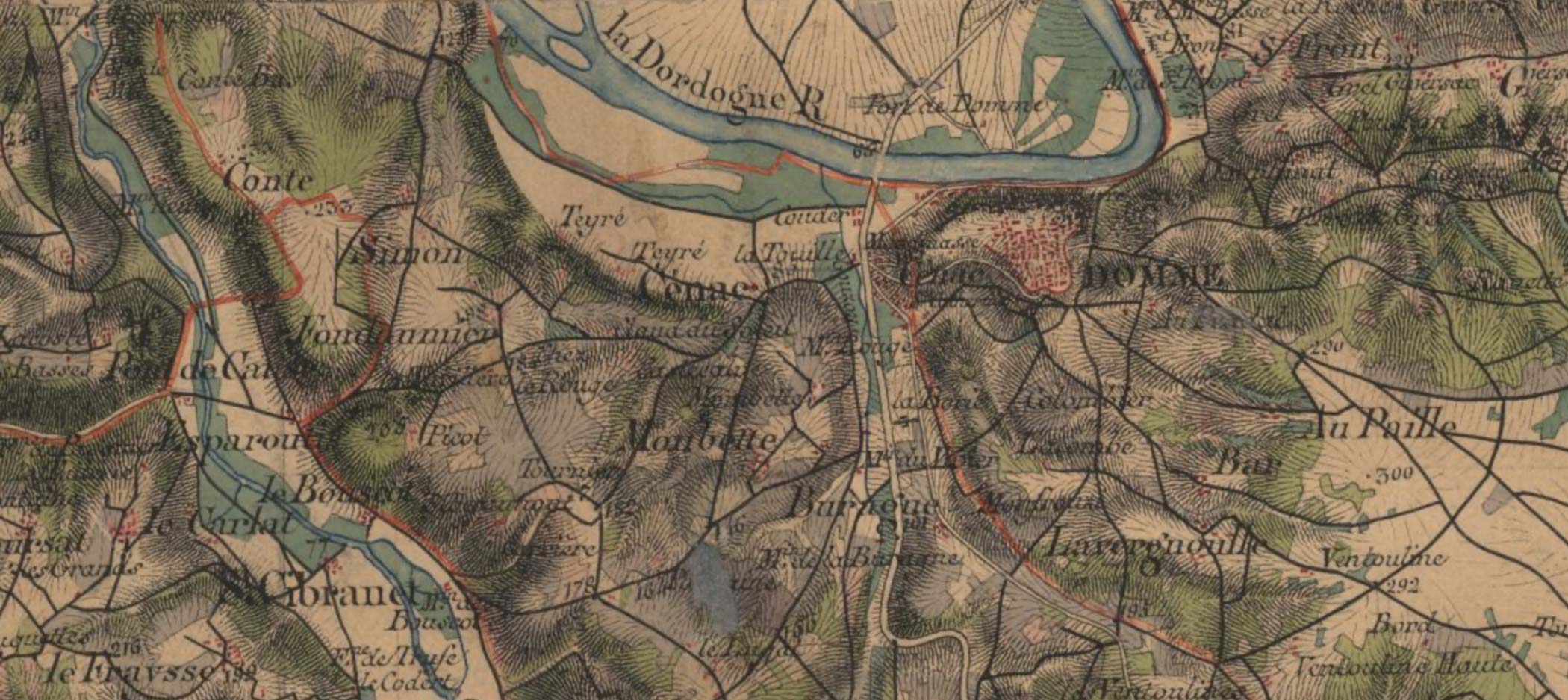Aiguevives (or viviers) in Cenac-et-Saint-Julien
Aiguevive was first named Domaine de Viviers in 1660, as it was then the property of the Labories de Campagne, the Cordis, Sieur de Vivier, and at the initiative of Antoine de Cordis, Chaplain of the King of France, who acquired it in 1612 from Jean de La Borie de Campagne. It was later ceded to Joseph de Labroüe, Sieur de Montgrieux.
The History of the Domain is originally linked to the operation of mills (wheat and walnut oil) and a deed of sale from the year 1480 allows us to date this then prosperous farm of Domme County.
The Château du Vivier is included on La Carte de BEYLLEME (Belleyme’s Map, 1762-1783, « Cartes topographiques de la Guyenne » n° 30, copper engraving), and its construction was dated mid XVIIIth century by several literary sources. In the XVIIIth century, Vivier appears in the succession of Bertand Malleville, sieur de la Treille, and in 1770, it is passed on to Joseph-Geoffroy de Bessou, sieur de Lacoste and Marobert through marriage. At the end of the XVIIIth century, it belongs to Jean Chassaing. The Manor was extended during the First French Empire after it was acquired by Etienne de Mouleydier, as confirmed by a very precise description of its composition and the composition of the domain’s outbuildings. In 1809, it is described as « a master house with a yard and two mills ».
« The elegant manor we can admire today started being transformed in 1813 when Jean-Baptiste Mercié, a notary from Domme, acquired it. Keeping with tradition, the house was extended with stones from the Château du Roy, a fortress erected on the Domme plateau during the Middle-Ages, and more specifically with the stones from the dungeon, also known as the Brown Tower, that Jean-Baptiste Mercié had bought from Jacques Molènes. The house was inaugurated during a private banquet on October 8th 1822, in the presence of numerous personalities. »
« In 1844, Jean-Baptiste Mercié, who lived in Domme, settles there. His daughter finally sells the Viviers to Henri de Maynard in 1872, a serviceman who had family ties at the Castle of Monbette, not far from here. In 1875, he also embellishes the house.
In 1904, Doctor Luc Lalande is the new owner of the Viviers. In September 1925, his widow and children sell it to painter Lucien de Malleville. A major restoration of the house, the outbuildings and the mill is initiated. Lucien de Malleville settles there with is wife in 1964. They’ll reside there alternatively with the Parisian region until the painter’s death in 1964″
Enriched texts of 2023 Anne Bécheau’s historical research Histoire du domaine de Vivier (Ayguevives) à Cénac et Saint-Julien, at the special request of Jean-Xavier Neuville.
Aiguevive Manor is mostly known thanks to Lucien de Maleville whose ancestor was Jacques, Marquis of Maleville and Peer of France, who co-wrote the Republic’s Civil Code. Lucien de Maleville, his descendant, was also enumerator of Historic Monuments. His descendent, Count Lucien de Malleville, renowned post-impressionist painter and also enumerator of historic monuments, acquired the domain at the beginning of the XXth century and set his workshop there. It became the place where he produced most of his work. Lucien de Maleville decided to rename his property (Vivier) to avoid the constant mistakes from the postmen who mistook Monsieur Maleville de Vivier, who owned a property a few yards away, and Monsieur Lucien de Maleville, who lived at the Vivier Manor. This is how Aiguevive Manor’s name was adopted.
In November 1997, Guy de Malleville, son of Lucien de Malleville, sold the property to Jacques and Fabienne Louge who started daunting landscaping and modernisation of the manor and its outbuildings. They were at the origin of the manor as it stands today, and created a green oasis by planting 400 walnut trees from 14 different varieties meant for the culture of walnut. They revived the tradition of oil manufacturing in the 2000s when they installed an authentic and ancestral mill.
Since April 2021, Aiguevive is the property of a French-Swiss couple. If the Manor remains a family house, the actual owners still initiated important renovations with the goal of opening to the public. Lucien de Malleville’s workshop was abandoned at the painter’s death and emptied of what it contained. There is nothing left of the artist’s workshop in Aiguevive. The outbuilding where he had settled was entirely renovated in 2022 and became a very plush lodge : Armelle’s House
As for the outbuildings, The Mill and its processing place were turned into event venues. Under the auspices of Agence Neuville, which celebrates Art de Vivre, cultural activities and events have been conceived there since 2023.

Several thousand years of history
The history of Perigord dates to Pre-history, even though no one knows why, 400 000 years ago, Périgord was a land that harboured prehistoric men. More than 80% of the world’s discoveries about this era were made by the Dordogne and Vézère rivers – decorated caves, paintings, sculptures, engravings, troglodyte habitats – its jewel being The Lascaux cave (-33000 BC) that Picasso baptised “Prehistory’s Sixtine Chapel”. Then comes the Middle-Ages with its castles, fortress and fortified towns built during the 100 years’ war between the kingdoms of France and England, with the Dordogne river as a frontier. Today, The Dordogne valley and its villages testify to the trade prosperity of Périgord thanks to its rivers as ways to transport it productions such as wood, walnuts, wine and the products of its metal industry.
World network of biosphere reserves
From the centre of France to the Gironde estuary, the Dordogne River runs along more than 300 miles (500km). Former trade route, it used to stand as a natural frontier between rival territories, as evidenced by the presence of its many fortified castles. With its preserved landscapes, it was recognized World Network of Biosphere Reserve’s by l’UNESCO on July 11th, 2012. It is the only French river to benefit from this prestigious label. On this occasion, the Dordogne Basin area joined the World Network of Biosphere Reserves which, in 2020, gathers 701 exceptional sites across the five continents.
World cultural and national heritage
The region supreme recognition was the protection and listing of the Vézère valley when it was added to the list of the World Cultural and Natutal Heritage by UNESCO. Under the label Prehistoric Sites and decorated Caves of the Vezere Valley, 14 sites in the Vézère Valley were ranked in the UNESCO’s World Cultural and Natural Heritage in October 1979. This true sanctuary of Prehistoric art is one of the most important archeological sites in Europe. After the first major archeological discoveries, the majority of this heritage is still accessible to the public : museums, sites, original decorated caves or their reproductions, thus allowing visitors to discover the History of the modern Man.
The city of Sarlat
One of Périgord most famous villages is without a doubt Sarlat, capital of Périgord Noir, a city of 10 000 inhabitants, and a jewel of Medieval architecture which attracts 1.5 million tourists each year. It harbours film shootings, festivals – theatre, film festival – Sarlat and its abundance of listed historic monuments compared with its surface places it at the top of the French list.
Around Sarlat, 10 riverside villages are listed as Loveliest Villages in France, and the valley itself is labelled Site Majeur d’Aquitaine. Its culture – apart from its architecture and the conservation of its historic monuments, (1500 listed sites), its remarkable garden such as Eyrignac and Marqueyssac.
Perigord Gastronomy
Perigord enjoys a gastronomic reputation thanks to the manufacturing of numerous quality products (PGI/PDO/AOC Protected Geographical Indication, Controlled Designations of Origin, Protected Designations of Origin for the Périgord foie gras, Périgord truffle, Périgord walnut, Périgord strawberries, Bergerac wines, chestnuts, boletus). Various animations around gastronomy are organised locally (salons and exhibitions) and attract a lot of visitors.
Internationally, Périgord gastronomy and its labelled products take an active part in the richness of French cuisine. History, landscapes and gastronomy all participate in making Périgord a place with a great quality of life, harmony and art de vivre, which are praised by the many tourists who visit Périgord each year.




